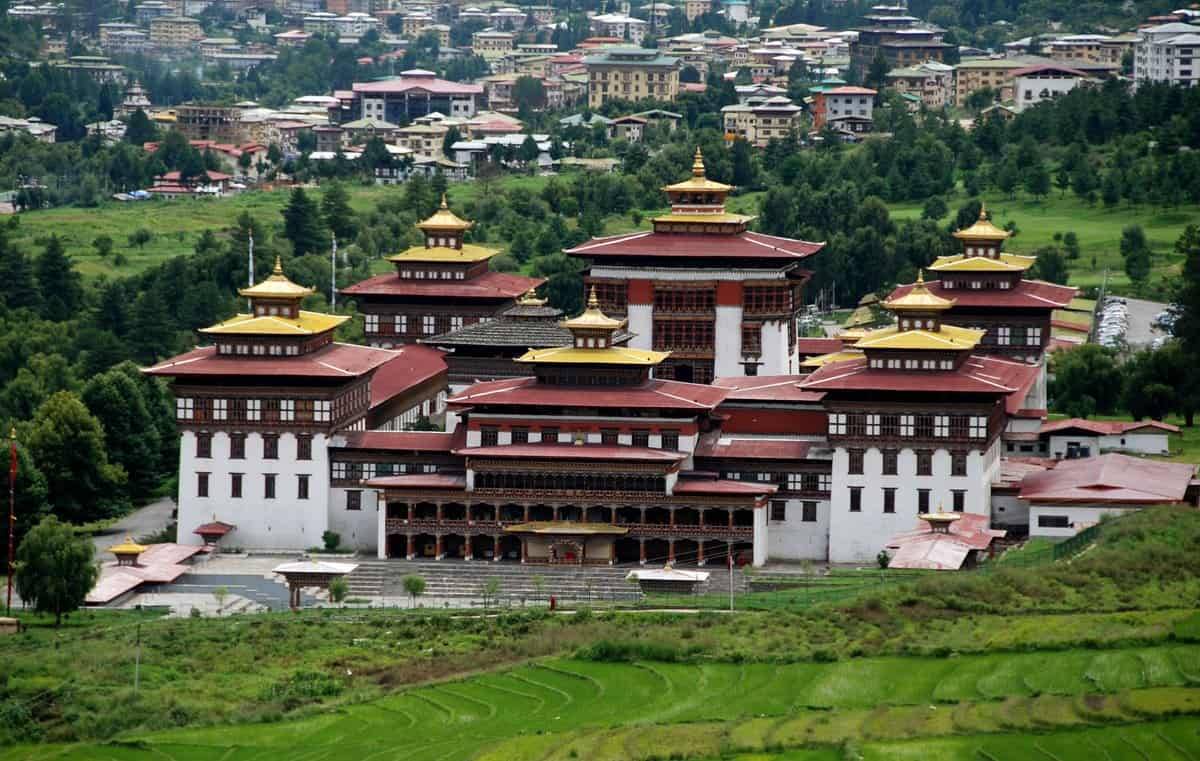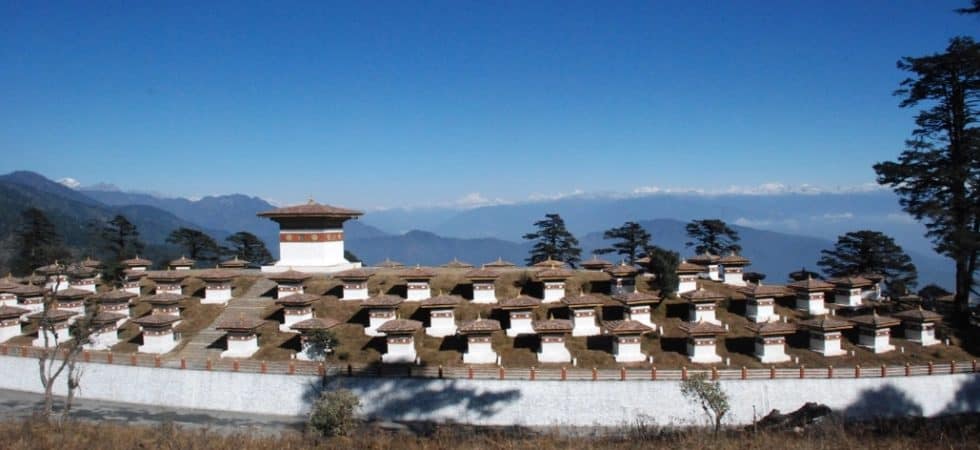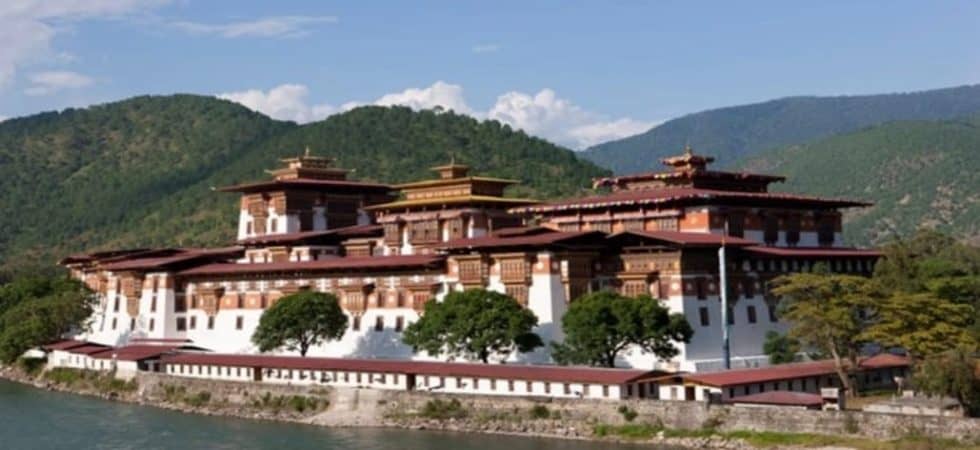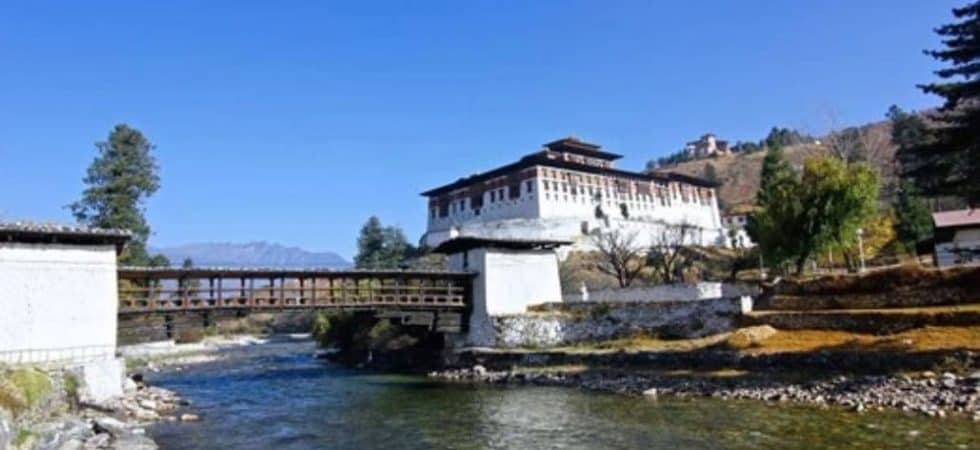Contact Us
Itinerary
Day
01
Arrive Paro –
Thimpu The flight to Paro is one of the most spectacular in entire Himalayas, the journey offers fascinating views and an exciting descent into the Kingdom. Bhutan’s first gift to you as you disembark from the aircraft will be cool, clean fresh mountain air.
Arrive at Paro International Airport from Kathmandu/Bangkok/Delhi. Paro is situated in a beautiful valley at 2280 metres and is a fitting introduction to this charming kingdom. Your guide will meet you and take you on a short one-hour drive along the Paro and Thimphu river valleys to Thimphu, Bhutan’s capital, at 2320 metres. You can stop on the way to take in the magnificent Tamchhog Lhakhang, the hereditary place of worship for Bhutan’s iron bridge builder. Take a late afternoon walk around town and soak in the atmosphere of this magical capital with its busy shops and bazaars and photogenic citizens in national dress.
In the afternoon, visit Tashi chhoe dzong, “fortress of the glorious religion”. This is the center of government and religion, site of monarch’s throne room and seat of Je Khenpo or Chief Abbot. Built in 1641 by the political and religious unifier of Bhutan, Zhabdrung Ngawang Namgyal, it was reconstructed in 1960s in traditional Bhutanese manner, without nails or architectural plans. Evening is at leisure.
Overnight: Thimphu
Day
02
Arrive Paro –
Thimpu The flight to Paro is one of the most spectacular in entire Himalayas, the journey offers fascinating views and an exciting descent into the Kingdom. Bhutan’s first gift to you as you disembark from the aircraft will be cool, clean fresh mountain air.
Arrive at Paro International Airport from Kathmandu/Bangkok/Delhi. Paro is situated in a beautiful valley at 2280 metres and is a fitting introduction to this charming kingdom. Your guide will meet you and take you on a short one-hour drive along the Paro and Thimphu river valleys to Thimphu, Bhutan’s capital, at 2320 metres. You can stop on the way to take in the magnificent Tamchhog Lhakhang, the hereditary place of worship for Bhutan’s iron bridge builder. Take a late afternoon walk around town and soak in the atmosphere of this magical capital with its busy shops and bazaars and photogenic citizens in national dress.
In the afternoon, visit Tashi chhoe dzong, “fortress of the glorious religion”. This is the center of government and religion, site of monarch’s throne room and seat of Je Khenpo or Chief Abbot. Built in 1641 by the political and religious unifier of Bhutan, Zhabdrung Ngawang Namgyal, it was reconstructed in 1960s in traditional Bhutanese manner, without nails or architectural plans. Evening is at leisure.
Overnight: Thimphu
Later, visit Punakha Dzong
Punakha Dzong or (Palace of Great Happiness), it was built at the junction of the Pho Chu and Mo chu rivers in 1637 by Zhabdrung Ngawang Namgyal. This majestic dzong served as both the religious and the administrative center of Bhutan in the past. It measures some 600 by 240 feet and has a six-story, gold-domed tower. Inside are courtyards and religious statuary that hint at the depth of history and spiritual tradition embodied here? Your guide will illuminate your understanding of this intricate culture that is exotic to us, though long established here.
The Chimi Lhakhang, situated on a hillock in the center of the valley, is dedicated to Lama Drukpa Kuenley, who in the late 15thcentury used humor, songs and outrageous behavior to dramatize his teachings and due to this also known as “Divine Madman”. This temple is also known as the temple of fertility. It is widely believed that couples who do not have children and wanting one, if they pray at this temple, they are usually blessed with a child very soon. It is about 30 minute walk across field from the road to the temple. The trail leads across rice fields to the tiny settlement of Pana, meaning “field”. It then follows a tiny stream downhill to Yoaka and across more fields before making a short climb to Chimi Lhakhang.
Overnight: Punakha
Day
03
Punakha –
Paro Breakfast is at hotel. Drive back to Paro [140Kms/04Hrs] The beautiful valley of Paro encapsulates within itself a rich culture, scenic beauty and hundreds of myths and legends. It is home to many of Bhutan’s oldest temples and monasteries, National Museum and country’s only airport. Mount. Chomolhari (7,314m) reigns in white glory at the northern end of the valley and its glacial water plunge through deep gorges to form Pa Chhu (Paro River). Paro is also one of the most fertile valleys in the Kingdom producing a bulk of the locally famous red rice from its terraced fields.
In the afternoon, walk down the trail (10 min walk) to visit Rinpung Dzong, meaning (“fortress of the heap of jewels”), which has a long and fascinating history. Built in 1646 by Zhabdrung Ngawang Namgyal, the first spiritual and temporal ruler of Bhutan, the Dzong houses the monastic body of Paro, the office of the Dzongda (district administrative head) and Thrimpon (judge) of Paro district.
The approach to the Dzong is through a traditional covered bridge called Nemi Zam. A walk through the bridge, over a stone inlaid path, offers a good view of the architectural wonder of the Dzong as well as life around it. It is also the venue of Paro Tshechu, held once a year in the spring. Later proceed to visit Ta Dzong, originally built as Watchtower, which now houses National Museum. The extensive collection includes antique thangkha paintings, textiles, weapons &armor, household objects and a rich assortment of natural and historic artifacts.
Overnight: Paro
Day
04
Paro
Breakfast is at hotel.
After breakfast, the morning is reserved for hike to Taktsang Monastery (approx. 5 hours walk including both ways).
The Taktsang Monastery is one of the most famous of Bhutan’s monasteries, perched on the side of a cliff 900 m above the Paro valley floor. It is said that Guru Rinpoche arrived here on the back of a tigress and meditated at this monastery and hence it is called ‘Tiger’s Nest’. This site has been recognized as a most sacred place and visited by Zhabdrung Ngawang Namgyal in 1646 and now visited by all Bhutanese at least once in their lifetime.
The hike to the monastery can be broken down into various stages. The first stage is the trek to the cafeteria (where lunch will be served later today) which is situated on a rocky outcrop across a ravine from the monastery. This leg of the trek takes approximately 45-60 minutes. The 2ndstage of the walk is from the cafeteria to the lookout opposite the monastery. This leg takes close to one hour. The 3rdstage is the trek/climb down the 475 steps in the cliff face to the bottom of the ravine which crosses over a stream and waterfall before the path again ascends another 300 odd steps to the entrance of the monastery.
Once here you should be able to enter into the monastery and view the cave where Zhabdrung Ngawang Namgyal meditated (cameras are not allowed inside the monastery). The visit and climb to the entrance and back to the lookout will take approximately one hour.
Kyichu Lhakhang, one of the 108 temples built in the Himalayas by Tibetan King, Songtsen Gampo. The building of this temple marks the introduction of Buddhism in Bhutan. It is one of the oldest and most sacred shrines of the Kingdom dating back to 7th century (the other is Jambey Lhakahng in Bumthang). The lhakhang complex is composed of two temples. The first temple was built by Tibetan King, Songtsen Gampo in the 7th century and in 1968, H.M. Ashi Kesang, the Queen Mother of Bhutan, built the second temple in original pattern.
Overnight: Paro
Day
05
Depart Paro
Early Breakfast is at hotel.
Transfer to Paro Airport for flight to onward destination.
Our representative will help you with exit formalities and then bid you farewell.




